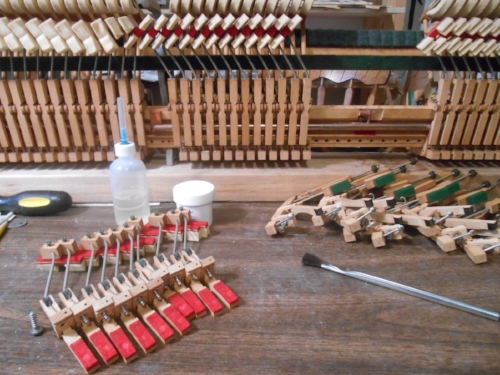Frequently Asked Questions
What Does One Get with a Standard Tuning Service with Smokeshire Piano Service?
I’ll set the pitch of the piano to the standard A440, tune the piano, and give your piano a general assessment which includes examining the action, pedals, keys, etc., for any obvious problems. I'll fix whatever can be easily fixed within the tuning visit and I’ll make notes on the condition of the piano for the owner’s use.
What's the Schedule of Fees?
Basic tuning: $160. This takes about two hours.
Regulation and repair: this varies depending on what needs to be fixed. A well-maintained piano that needs touch-up regulation might take one hour. A piano that's been neglected for years will likely need considerable work.
Other than tuning, the hourly rate is $80. Travel expense for service calls is $1.00 per mile after the first 20 miles; the first 20 miles are free.
Is Work Guaranteed?
All work is guaranteed to be consistent with the highest standards of the Piano Technicians Guild. If you're unhappy with my work, I'll fix the problem for free. My goals are happy pianos and happy customers.
Refurbishing a spinet piano action.
How Often Should a Piano be Tuned?
For typical home use, pianos should be tuned twice per year.
What About Repairs and Regulation?
There are thousands of minutely-adjusted moving parts in a piano that can become worn or distorted with age and use. Regulation of the piano involves setting alignments and movements to specifications. This is usually done on-site, but sometimes the action of the piano has to be taken to the shop. Once properly regulated, a piano should work in good condition for many years, with occasional small adjustments to keep everything in order.
The fineness of regulation depends on the pianist. The best pianists are very particular about the sound and touch of the piano. But, even beginning pianists will have an easier time of it if the piano action is functioning the best that it can, and as designed.
What's the Best Way to Preserve the Piano?
Keep your piano away from heaters, air conditioners, and outside walls and windows, if possible. Aside from that, the best way to maintain the stability of the piano is to have a Dampp-Chaser humidity control system installed inside the piano itself, as changes in humidity affect all parts of the piano. These systems are designed specifically for pianos and take about two hours to install. I’m a Certified Dampp-Chaser installer. Click here for information on these systems.
Preparing to regulate a grand piano.
What's the Service Area?
The general service area is southern Vermont centered around Andover, Vermont, where I live. This would include Chester, Bondville, Weston, Woodstock, Springfield, Ludlow, Londonderry, Rutland, Manchester, Grafton, Wilmington, etc. I’m usually happy to travel outside the general service area; please note that after the first 20 miles, I charge $1.00/mile for travel expenses.


